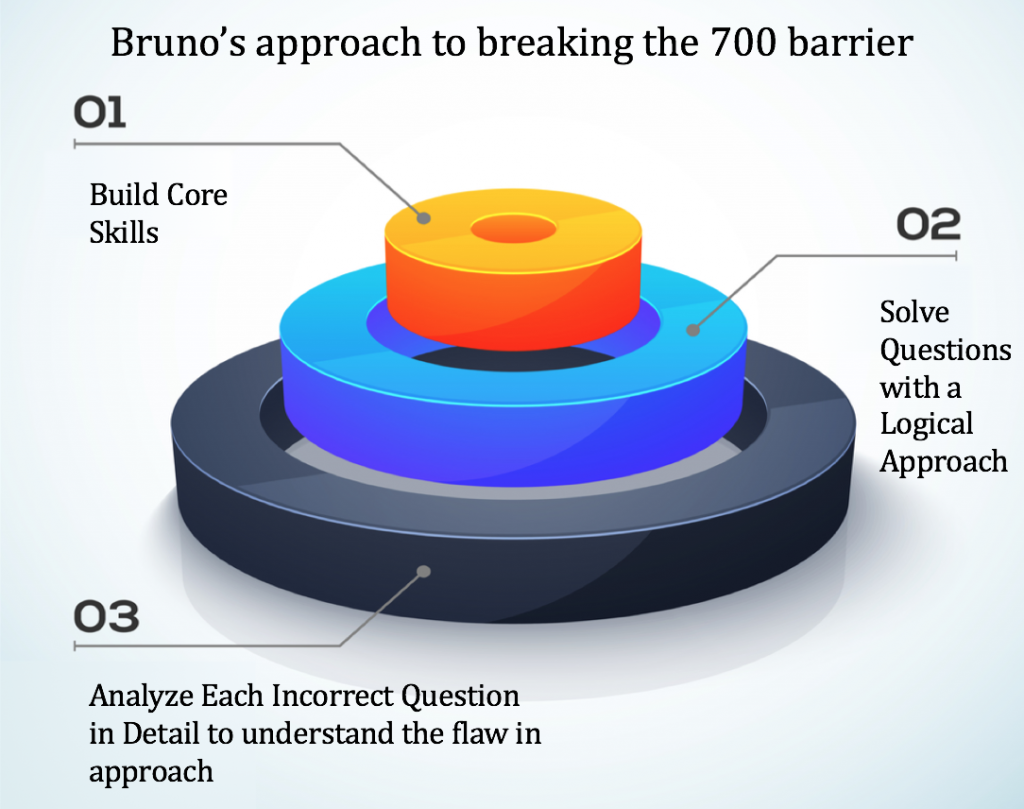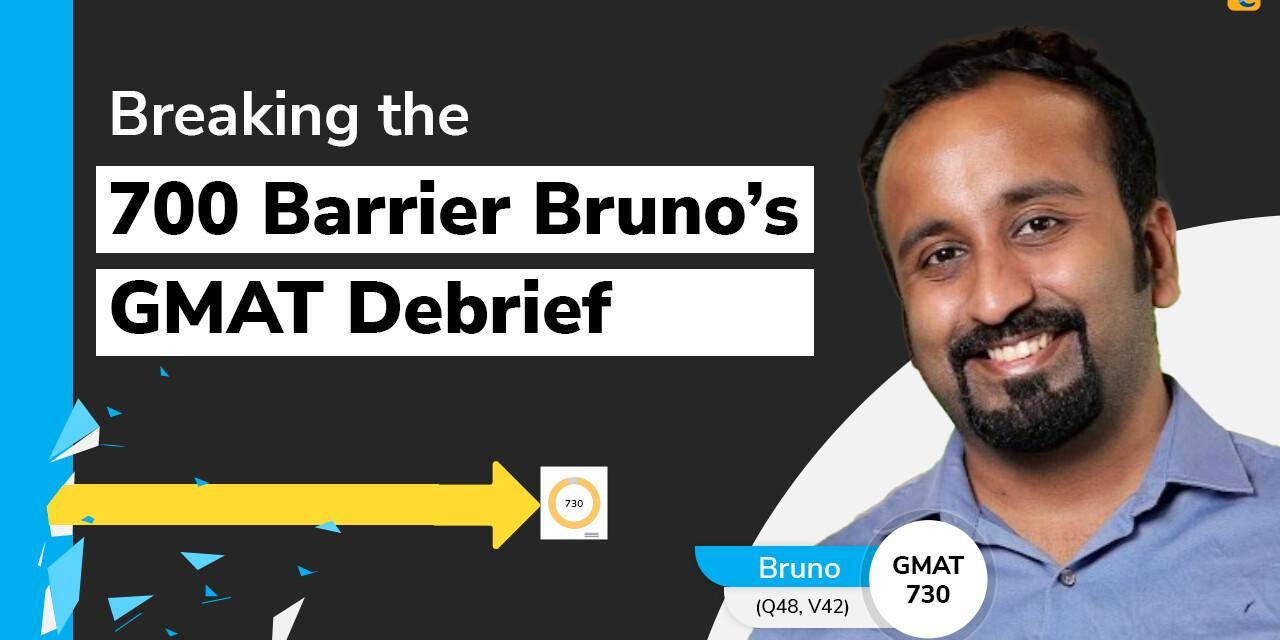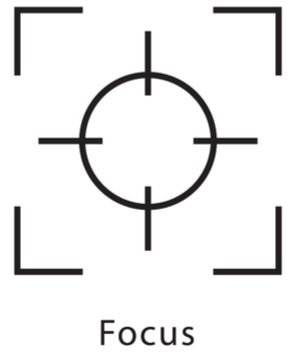After scoring a 540 on his first GMAT mock, Bruno Nelli took a hiatus of one month from his work. During this time, he focused solely on his GMAT preparation and ended up with a stellar score of 730. His story is of focus and a will to constantly improve. The key to his success behind breaking the GMAT 700 barrier is DILIGENCE. During his preparation, he focused on the following –

- Building core skills
- Following a logical approach to solving questions
- Analyzing each question in detail
Many of you might feel that you’re clueless about GMAT preparation. If you have limited time with you and don’t have any idea about where to start and how to start your preparation, this success story will help you start with your preparation with confidence. Take a look at this amazing video de-brief of Bruno – breaking the 700 barrier. Alternatively, you can also read his 1-month preparation strategy below.
Rajat – Congratulations on scoring a 730 in the GMAT. Scoring a V42 is very impressive.
Bruno – Thank you Rajat. Before starting preparation, I was more concerned about my Quant score as I felt that Verbal was my stronger section. I was educated in a convent school. Moreover, my college was situated in Bandra, Mumbai and conversing in English was the norm there. I never faced issues with English grammar. In fact, my office colleagues used to ask me to proofread the content of the e-mails. So I assumed, I should do well on the Verbal section of the GMAT. However, I got stumped while attempting Verbal questions from Official Guide even after preparing for 2 weeks. I realized I need to change my approach to improve.
Rajat – So, you scored a 540 in your first mock. Did you go through the Official Guide before or after the mock?
Bruno – I took the mock before going through the OG. The score was way below my expectation. I was targeting the Executive MBA program of IIM Ahmedabad, and therefore needed a minimum GMAT score of 550. I thought I would score even less on the actual test day as the actual test day is more stressful. So, I wanted to target at least 650 on the GMAT.
Your GMAT score is accepted for admission into 140+ Business Schools in India including top schools like IIMs and ISB, learn more about the scope of GMAT in India in this article.
Rajat – What did you do next to achieve your target score?
Bruno – I took a brief hiatus from my office to prepare for the GMAT full-time. I was searching for GMAT prep courses and started considering e-GMAT. I went through the reviews and most of the positive reviews were for e-GMAT. Next, I registered for your free trial. I was very comfortable with the content. Moreover, I was taking the GMAT in one month, so felt that going for the best would be the wisest choice. That’s how I started my GMAT preparation.
Rajat – Breaking the 700 barrier in just 1 month is a remarkable feat! How did you go about preparing for the GMAT?
Breaking the 700 Barrier – 1 Month Study Plan for GMAT 730 |
||
| Week | Daily Study Hours | Focus Areas |
| Week 1 | 12 hours | Building core skills in Verbal |
| Week 2 | 12 hours | Building core skills in Quant |
| Week 3 | 6-7 hours | Develop a logical approach to solving questions. Practice Scholaranium and OG Questions |
| Week 4 | 4-5 hours | Analyze each question in detail to refine the logical approach |
Time management in the GMAT is critical for a good GMAT score. Learn the best time management strategies in this article.
Bruno – I finished the concept files of Quant and Verbal in 2 weeks. I observed that the questions in Scholaranium were comparatively more difficult to solve. Since I crammed so many concepts in a short period of time, my brain was saturated. Hence, I took a break and tried Scholaranium questions the next day, and I started performing better. I made sure I reached a good level of accuracy in all the sections. For example, I was at 92%ile in SC Scholaranium. Next, I went back to the OG. I did 40 questions for Verbal and Quant each. I didn’t put a lot of pressure on myself, simply prepared in a planned and consistent manner following the study plan that I had created.
Rajat – How did you change your approach to solving Verbal questions after going through e-GMAT’s course?
Bruno – I realized that I had to understand the logic behind the questions. Once the pre-thinking was done, something which e-GMAT uses extensively in its concepts, it was only about looking at the answer choices and getting the final answer.
For example, while going through Reading Comprehension questions in Scholaranium, I used to summarize everything in my head and then answer the questions. But this approach did not work. So, I started summarizing each paragraph and noting down the important takeaways, then I would combine all of them and reach a conclusion.
Attend our free webinar on Pre-Thinking and learn how to tackle 700+ level GMAT CR Questions with ease.
The shortcut driven approach which tells you to read 20% of the passage and start answering questions does not work correctly. It is a waste of time.
Rajat – How did this approach of writing down the summary help you in other sections?
Bruno – This approach helped me in the AWA section but in the reverse order. The argument was presented and I wrote down statements and based on each I made up a paragraph and added real-life examples and ultimately, I got a perfect 6 on the AWA section.
Rajat – How many hours did you put in every day? Did you follow a particular routine?
Bruno – Initially I studied 12 hours a day for 2 weeks where I focused on building concepts. In the next week, I studied for 6-7 hours and focused on Scholaranium. The last week was mostly spent in reviewing the weak topics and mistakes in questions.
I studied 3-4 hours per day in the last week. I followed the following schedule: During the first 2 weeks, I would start at 7 am and study until 1 pm. Take a 1-hour break and resume from 2 pm till 5 pm. Again, a 1-hour break followed by studies from 6 pm to 9 pm. After the 2 weeks, I would study in the morning hours and spend the afternoon reviewing the logic behind the questions I answered incorrectly.
| Bruno’s Daily Schedule for 4 weeks | |||
| Week 1 and 2 | Week 3 and 4 | ||
| 7 am to 1 pm | Study Concept Files | 9 am to 1 pm | Scholaranium and OG questions |
| 1-hour Break | 2-hour break | ||
| 2 pm to 5 pm | Study Concept Files | 3 pm to 6 pm | Review mistakes |
| 1-hour break | |||
| 6 pm to 9 pm | Study Concept Files | ||
Rajat – How did you evaluate the questions you answered incorrectly?
Bruno – Scholaranium provides an explanation for each answer. So, I would compare my response with the correct answer and understand the logic used to arrive at the right answer. This way I understood the flaw in my approach. Doing so helped me understand the minute details in each question that are necessary to choose the correct option. These details might be minute, but it makes a huge difference in understanding the logic to arrive at the right answer.
Rajat – A lot of our students preparing full time, face a problem with keeping their focus on the preparation. How did you keep yourself focused?
Bruno – Keeping myself focused was also a big challenge I faced. There were times when I used to feel saturated and couldn’t focus. So, at those times I would take a short break and indulge myself in activities that I liked. I liked listening to music and playing short games. It would refresh my brain and let me focus on the preparation.
Rajat – Did you attempt any mocks before taking the actual GMAT?
Bruno – I took just one mock before preparing for the GMAT. My whole strategy was to build core skills and understand the logic to solve problems. Under the pressure of a mock, I might not have performed to the best of my ability. Hence, instead what I did was attempt OG questions online. They have a timer with every question. So, I started timing myself. My approach was simple:
- Build core skills
- Improve timing
This approach worked for me. The main purpose of a mock is to build focus during the test. I was diligent during my preparation and had imbibed the focus required during the test.
The e-GMAT course helped Bruno prepare at his own pace with a comprehensive library of concept files. Scholaranium provided a true assessment of his skill level throughout his preparation. Based on skills data from Scholaranium, Bruno improved his weak areas and felt confident before taking the GMAT. The result was a 730 in GMAT.
If you are also planning to ace the GMAT and breaking the 700 barrier, and don’t know where to start, write to us at acethegmat@e-gmat.com. You can also take a look at a free webinar on GMAT Strategy and then take a free trial of our online GMAT preparation courses.
















